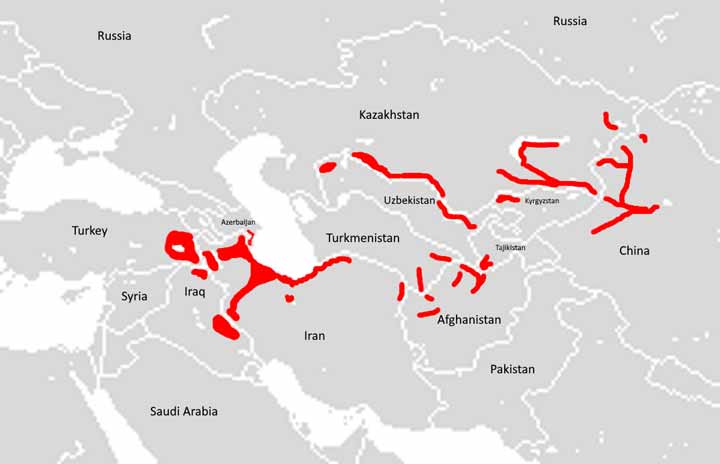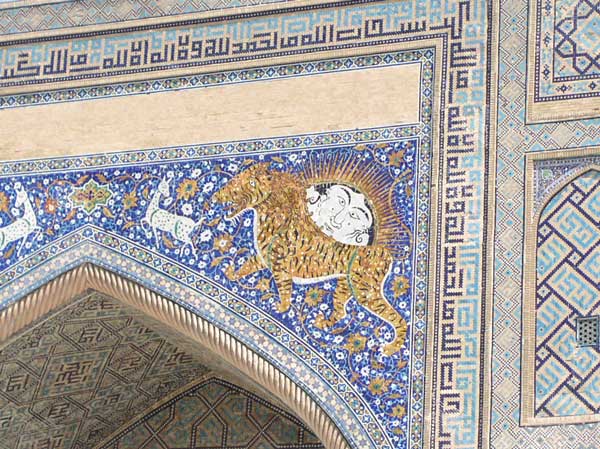The Caspian tiger, a majestic creature that once roamed the vast landscapes of Central Asia, stands as a testament to nature’s splendor and the delicate balance of ecosystems.
Though marred by its tragic decline, its legacy inspires reverence and a deeper understanding of our role in preserving the world’s biodiversity.
Quick Overview
| Habitat | Wetlands, riverine corridors, lake edges |
| Weight | Male: 170-240 kg (375-530 lbs) Female: 85-135 kg (187-298 lbs) |
| Length | Male: 9.8 feet Female: 8.7 feet |
| Diet | Wild pigs, smaller mammals, fish |
| Conservation Status | Extinct (last confirmed sighting in the early 1970s) |
| Population | Extinct |
| Primary Threats | Overhunting, habitat destruction, diseases |
| Cultural Significance | Revered in ancient texts, represented in art and folklore, symbolizing strength and majesty. |
Taxonomy
The Caspian tiger’s taxonomic journey has been a tale of evolving understanding. Initially classified as Felis virgata by Johann Karl Wilhelm Illiger in 1815, it was based on its distinct skin patterns and coloration.
Konstantin Satunin, in 1904, proposed the name Tigris septentrionalis for specimens found in the Lankaran Lowland. By 1929, Reginald Innes Pocock had reclassified the tiger under the genus Panthera.
The turn of the 21st century brought significant revelations. Genetic studies in the early 2000s indicated a close relationship between the Caspian and Siberian tigers, suggesting a shared ancestry.
By 2015, comprehensive studies proposed that the Caspian tiger should be recognized under the subspecies P. t. tigris. However, debates continued, and by 2018, some genetic studies supported the traditional concept of distinct subspecies, including the Caspian tiger.
| Kingdom | Animalia |
|---|---|
| Phylum | Chordata |
| Subphylum | Vertebrata |
| Class | Mammalia |
| Order | Carnivora |
| Suborder | Feliformia |
| Family | Felidae |
| Genus | Panthera |
| Species | Panthera tigris |
| Sub Species | Panthera tigris tigris |
Physical Attributes

The Caspian tiger was a marvel of nature’s design. Males, robust and imposing, weighed between 170-240 kg (375-530 lbs) and measured up to 9.8 feet in length. Though slightly smaller, females were no less majestic, weighing in at 85-135 kg (187-298 lbs) and reaching lengths of up to 8.7 feet.
Their fur, a vibrant mix of oranges and whites, was adorned with a unique strip pattern, serving as camouflage and a symbol of their individual identity.
Distribution and Habitat

From the shimmering shores of the Caspian Sea to the rugged terrains of Iran and the expansive landscapes of western China, the Caspian tiger’s domain was vast. These landscapes, rich in biodiversity, offered the tiger a variety of habitats.
Dense reed beds, riverine forests, and vast grasslands provided the perfect backdrop for the tiger’s life, offering shelter, hunting grounds, and vantage points.
Behavior and Ecology
The Caspian tiger’s behavior was a testament to its adaptability and prowess. Solitary by nature, these tigers had well-defined territories, often spanning vast areas. Their diet was varied, showcasing their versatility as apex predators.
Deer, wild boar, and smaller mammals formed the bulk of their diet, but they were also known to hunt birds and fish when the opportunity arose.
Extinction

The tragic decline of the Caspian tiger began in earnest during the late 19th century. As the Russian colonization of Turkestan progressed, the tiger faced threats from overhunting, habitat destruction, and diseases.
The last confirmed sighting of a Caspian tiger was in the early 1970s in Turkey’s Hakkari province. In 2003, the IUCN assessed the Caspian tiger as extinct.
The rapid industrialization, coupled with agricultural expansion, led to significant habitat loss. The construction of canals and draining of significant sites for rice cultivation further fragmented their habitat.
Additionally, the tiger’s primary prey species also faced decline due to hunting and habitat changes. All these factors combined led to the unfortunate extinction of the Caspian tiger.
Conservation and Reintroduction Project
Despite the Caspian tiger’s extinction, hope remains. Conservationists and scientists are exploring the feasibility of reintroducing the Siberian tiger, a close relative of the Caspian tiger, to Central Asia. This ambitious project aims to restore a semblance of the region’s lost biodiversity.
In Culture

The Caspian tiger, with its majestic presence, has left an indelible mark on various cultures. From being revered in ancient texts to its representation in art and folklore, the tiger symbolizes strength, courage, and majesty.
Its legacy continues to inspire and reminds us of the rich biodiversity that once flourished in Central Asia.
Conclusion
The narrative of the Caspian tiger is not just a chronicle of a species but a reflection on humanity’s relationship with nature.
While the echoes of their roars may have faded, the lessons they leave behind resonate loudly, urging us to champion the cause of conservation and to tread lightly on this shared planet.
FAQs
The Caspian Tiger was a tiger subspecies that once lived in Central Asia but is now extinct.
It inhabited the regions from eastern Turkey to western China, primarily along riverine corridors.
Overhunting, habitat destruction, and diseases contributed to its extinction.
The last confirmed sighting was in the early 1970s.
There are discussions about reintroducing tigers to Central Asia using the closely related Amur tiger.
It was distinguished by its vibrant fur with dark stripes and its unique habitat preferences.




